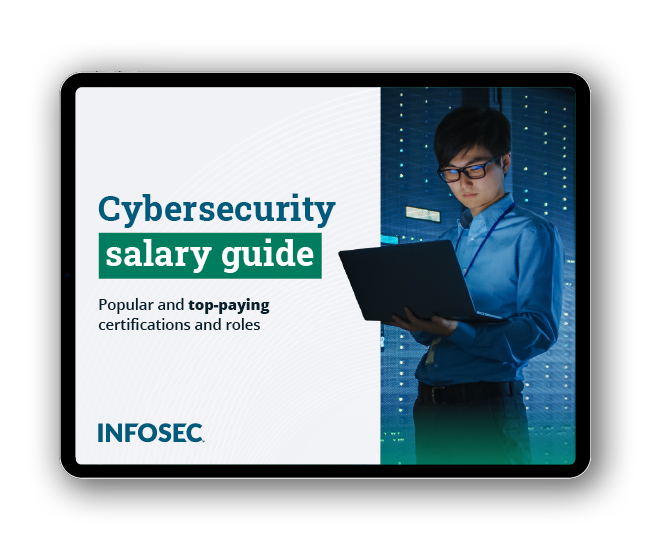The role of the chief information officer (CIO) in cybersecurity
The role of a chief information officer (CIO) has evolved, making these professionals one of the most important building blocks in a successful company’s foundation. Even though CIOs have traditionally managed technology acquisition and support, they now find themselves leading cybersecurity teams and battling constantly developing threats.

The CIO wears many hats and must be adept in technology, leadership and business.
In many organizations, the CIO must double as a cyber war general, always staying a step ahead of bad actors and discovering innovative ways of safeguarding digital assets. In the digital age, this is essential because data lies at the heart of modern business models. Whether it’s customer data, company data or the networks that manage it, a CIO has several cybersecurity challenges to meet.
FREE role-guided training plans

Historical evolution of the CIO role
CIOs first stepped into the boardroom in the 1980s as computers started playing a major role in business operations, information management and decisions. Fast-forward to now and cloud computing has added more import to the CIO role. An effective CIO can save an organization considerable money and even discover new revenue streams using cloud resources. Of course, if these aren’t kept secure, the CIO’s efforts could backfire, exposing the organization to new risks.
Wireless communications have added more to the CIO plate, especially because attackers can take advantage of wireless connectivity using man-in-the-middle attacks and fake networks.
Big data analytics adds another wrinkle, putting data at the heart of many companies’ operations and decisions. The CIO must not only source the best big data analytical solution but also has to make sure data is safe in storage and while in transit.
The CIO's role in today's digital landscape
The CIO’s role in the context of the modern digital landscape is as deep as it is ubiquitous. The CIO must be:
-
A strategic partner and enabler of modernization goals. Guiding digital transformations puts a CIO at the center of growth and innovation programs that can keep a company competitive longer.
-
A technological strategist. As they intertwine technology what daily functions, CIOs help employees be more productive and businesses win and retain more customers.
-
A workforce enabler. The CIO assesses the effectiveness of a company’s workforce, particularly in the context of how technology is helping produce higher-quality outcomes.
-
A budget strategist. Since digital investments can consume considerable portions of yearly budgets, CIOs must factor in intricate budgetary considerations on a regular basis.
-
An investment manager. As companies pour money into their digital assets and the technology needed to protect them, CIOs play a significant role in deciding where money should go and making sure each investment generates a handsome ROI.
-
An information security specialist. The CIO’s role as a cyber protector often extends to managing security engineers and evaluating the performances of their solutions.

Get your guide to the top-paying certifications
With more than 448,000 U.S. cybersecurity job openings annually, get answers to all your cybersecurity salary questions with our free ebook!
CIO and cybersecurity
A CIO must establish and run a company-wide information security program. As the chief information officer, they’re often held responsible for the effectiveness of cyber protections.
The CIO and the Chief Information Security Officer (CISO) work closely to establish and manage a company-wide information security program. CIOs are usually responsible for the information systems infrastructure, so they need to collaborate with CISOs to gain a deeper understanding of the tools and techniques used to secure digital resources.
To be more effective, CISOs and CIOs should work closely together. While CISOs focus on protecting the infrastructure, CIOs ensure that the infrastructure is reliable, scalable and accessible. This enables CISOs and CIOs to better predict and address cybersecurity threats, which helps keep businesses safer.
Key responsibilities of a modern CIO
Nowadays, a CIO must wear a lot of hats, with a portfolio of responsibilities that includes:
-
Overseeing how team members manage, integrate and use data and IT resources
-
Directing development teams as they build customer service applications and platforms
-
Managing detailed IT budgets while making sure each tech investment gets a substantial ROI
-
Listening to and reacting to the information security concerns of other stakeholders
-
Making sure their company remains within internal and external compliance boundaries
Skills and qualifications for a successful CIO
The educational background of a successful CIO should include certification programs that give evidence of competence and experience. If you can demonstrate you’ve designed, implemented and managed successful programs, this may carry more weight than a shiny diploma from a top-tier university.
At the same time, a computer science degree or an MBA with a focus on information systems can also put you in a good position to land a job with the kind of salary you’re looking for.
Each company has different certification requirements, but here are some of the most common:
Having one or more of these under your belt shows interested companies that you have the knowledge to build, maintain and secure information systems, as well as help team members make business-critical tech decisions.

Communication and interpersonal skills are essential CIO skills.
The list of skills a CIO needs to be successful is as diverse as their responsibilities. They include:
- The ability to manage large and small teams
- Research and analytical skills
- The ability to make decisions using critical thinking
- Strategic planning acumen
- Being comfortable with organizing people and complex tasks
- Leadership
- Strong interpersonal skills
- Being able to communicate with a diverse range of stakeholders
The CIO in 2024: Predictions and trends
Cybersecurity continues to grow as an important branch in the corporate tree. In 2024, the CIO will continue to take the lead — and assume the weight of responsibility — when it comes to protecting organizations from threats.
This is especially true given the increase in demand for CIOs as computer technology plays a more dominant role in business. Everything from big data to networking to efficiency enablement depends on technology under the CIO’s purview.
In addition, a CIO must keep a few challenges front and center as they plan for the future:
-
More sophisticated cyber attacks by threat actors with limited skills. Thanks to ransomware as a service (RaaS) and other TV dinner-style, pre-baked attacks, the number of threats may continue to increase.
-
AI-enabled threat actors. Cybercriminals are using AI to write convincing phishing emails, architecture and plan attacks and even write malicious code.
-
Keeping up with competitors who adopt new technologies. A CIO must find a balance between being an early adopter and the risk involved in trying something new just to keep up with the Joneses.
At the same time, each of these challenges presents opportunities. For example, by using novel methods for beating cybercriminals, a CIO can emerge as a leader in their sector, creating a blueprint for success others may want to follow — and pay a considerable salary for.
Also, by thoroughly researching, sourcing and using new technology, a CIO can foster a significant ROI for their company. Tech wins add a nice shine to any resume.
The importance of a chief information officer in cybersecurity
A CIO takes the lead in ensuring the cybersecurity of an organization. They help both the IT team and those in other departments understand and combat threats — all the while setting the pace when it comes to identifying and using the most effective cyber protection technologies. Organizations should prioritize cybersecurity to maintain the confidence of customers and employees. This requires an investment in competent CIO leadership.
Want more? Visit the Infosec Security Manager hub for additional resources on leading IT and security teams.








